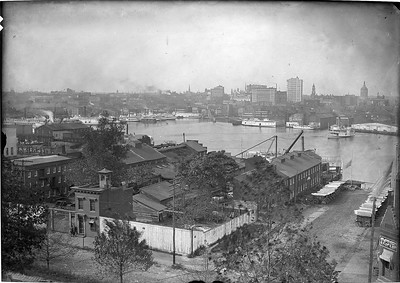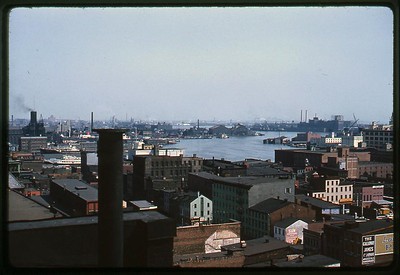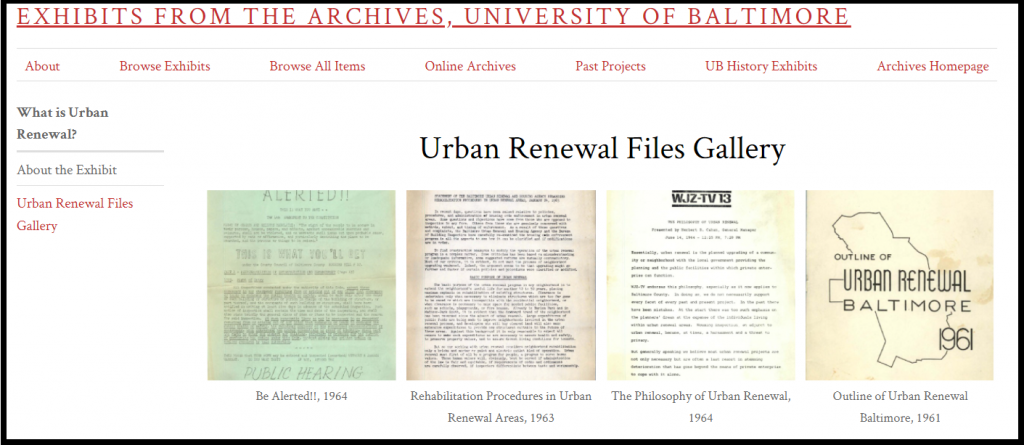Over the years, the Baltimore Harbor has seen many changes and has long acted as a major shipping hub, a tourist and sightseeing attraction, a city center of sorts, and a major U.S. landmark. The Inner Harbor has also become a signature of the city.
However, the Inner Harbor that we know and love today, has not always looked as it does now. It has seen many changes in its development over time, and thanks to the resources at UBalt Special Collections & Archives, we are able to take a look back at that progression. The archives holds collections of records and photographs that show us just how much the harbor and surrounding areas have changed over the years.

So are you ready to learn more about Baltimore’s port, the Inner Harbor, urban renewal, the road fights, and more? Do you want to learn how these issues have effected the growth of the Inner Harbor and the Baltimore City community? Then we hope you find the resources in this post helpful!
One good resource you could check out first is this Port of Baltimore Guide dated roughly in the 1940s and 1950s from the Greater Baltimore Committee Records in the archives. Click the Red Icon via the link to view the digitized PDF and learn more about the World Port of Baltimore.
In the mid-twentieth century there were many plans to begin developing and updating the Inner Harbor and other neighborhoods in Baltimore. Learn more about the changes, and plans for the Inner Harbor with The Inner Harbor and Municipal Center Plan Technical Report from the Greater Baltimore Committee Records.

The Greater Baltimore Committee Records are a great resource for anyone interested in learning more about the Inner Harbor’s history and urban renewal in general in Baltimore City. Many of these records have been digitized and are available online like the Port of Baltimore Guide above.
The Waterfront Coalition Records are also a useful resource for researchers interested in learning about the growth and urban renewal of the Baltimore Inner Harbor, Fells Point, Canton, Butcher’s Hill, Harbor East, and other areas surrounding the Baltimore waterfront between the 1980s and 2000s. These records have not been digitized, but you can always make an appointment to visit the archives or request virtual assistance. Just submit a request!
The What is Urban Renewal? digital exhibit and the Urban Renewal Files collection finding aid are two other helpful resources for those interested in urban renewal in general in Baltimore City between 1960 and 1970.

The many changes and the development that the city, and in particular the Inner Harbor, have gone through have not always been welcomed by neighborhood communities. Over the course of the mid 1960’s through the 1970’s, in addition to the urban renewal efforts, there were also plans for construction of highways and expressways that would run through the heart of the city. These plans were met with a great deal of backlash from the city’s communities who valued their historic neighborhoods.
Known locally as the “Road Fights,” the ensuing civil suits and protests were a hot button issue in the Baltimore community. For more than a decade, public officials, community organizers, and local citizens in debate, public hearings, and deposition. Records of these events, including digitized photographs and documents are held by UBalt Special Collections & Archives.
View the Stop The Road! Records from the Road Fights digital exhibit to view digitized documents. And check out the collection finding aid for Movement Against Destruction Records.
Another digital collection featuring records from the UBalt Special Collections & Archives is available through Digital Maryland as the Road Fight Collection.
Remember there are many other related resources available through the UBalt Special Collections & Archives.
- Search the finding aids database for more collections
- Learn how to get started with your research in the archives
- Submit a question or request
Good luck with your research!
___________________________________________________________
This post was written by Thomas Dettling, UB undergraduate student and Special Collections & Archives student worker.